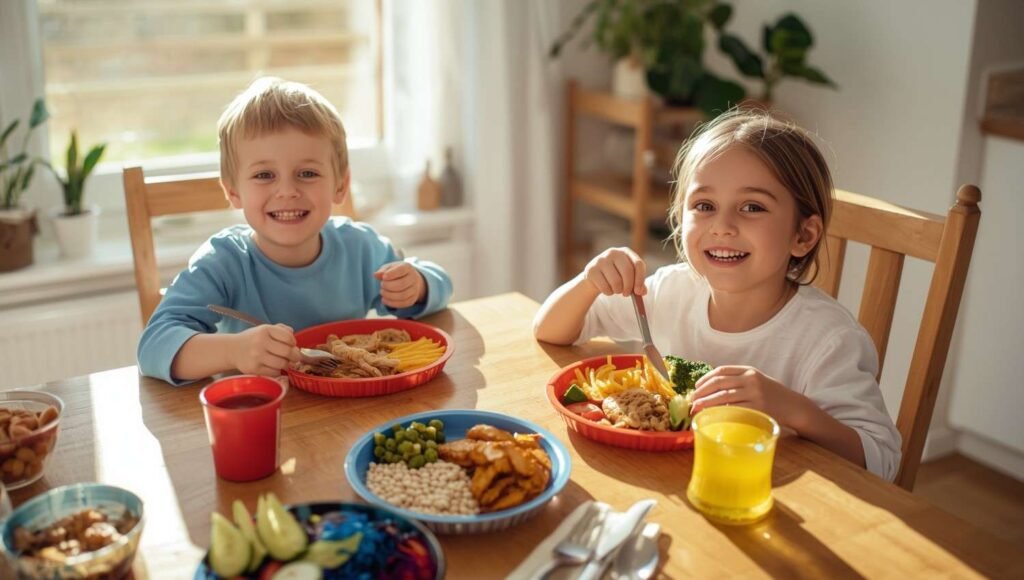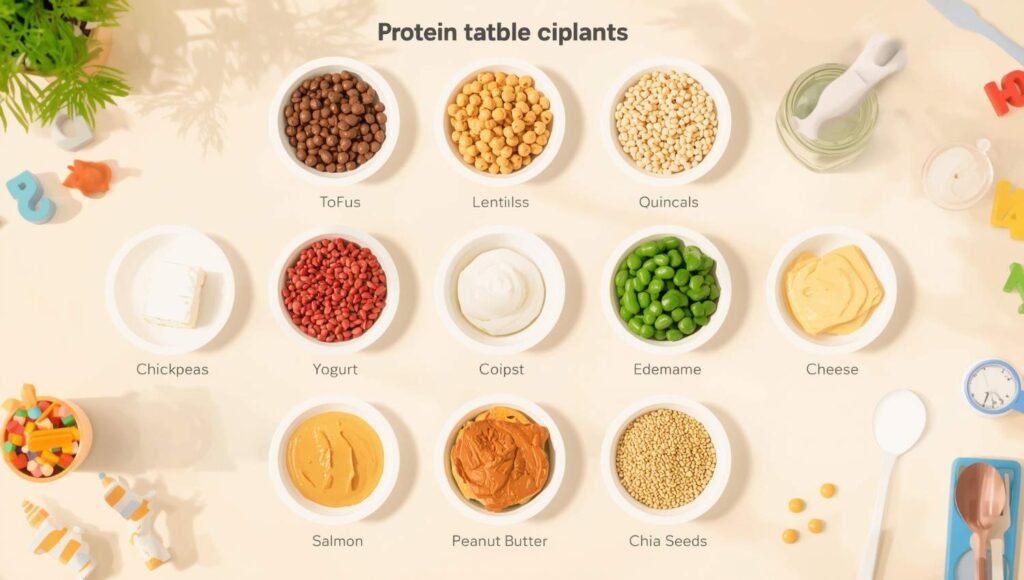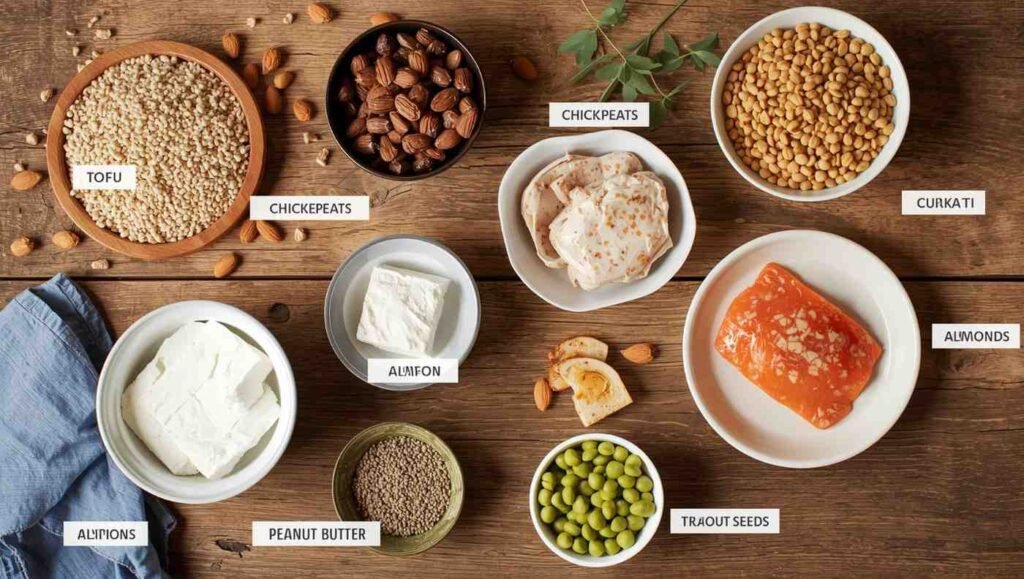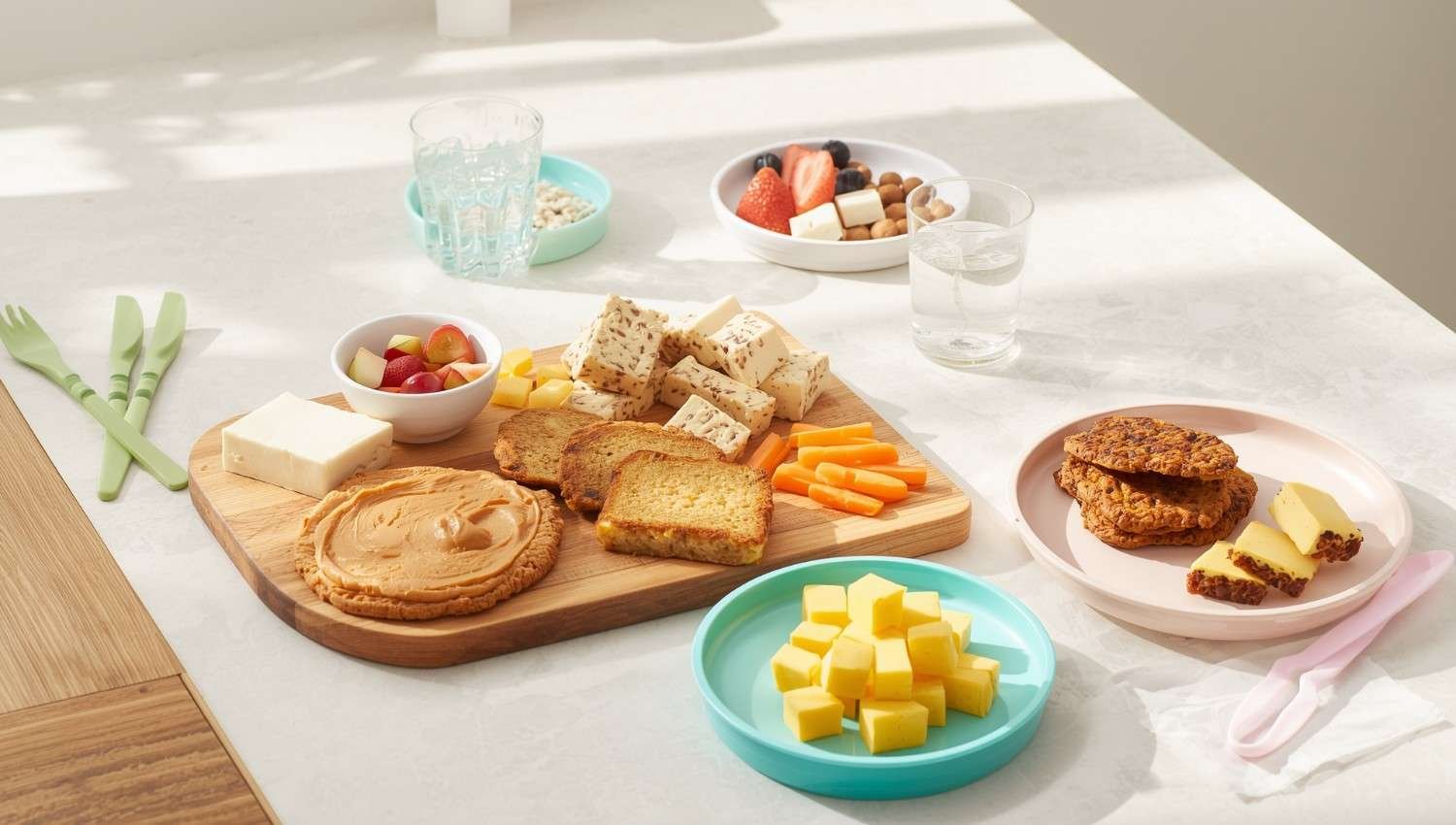Introduction
As a parent, I’ve learned that protein is truly the cornerstone of my child’s growth and development. It’s the building block that strengthens muscles, tissues, and organs, playing a vital role in both physical and mental progress. From boosting the immune system to supporting brain function, including protein-rich food for kids, is simply non-negotiable. Many children often fall short of their protein requirements, leading to deficiencies like stunted growth, weakened immunity, and fatigue. That’s why creating a balanced meal plan is so crucial—a balanced diet not only ensures the right amount of protein but also supplies essential nutrients like carbohydrates, fats, vitamins, and minerals.
As a mom who enjoys mealtime creativity, I find that understanding the role of protein and incorporating it into my child’s daily meals sets the foundation for a healthy, thriving future. To make meals fun and manageable, I use Avanchy’s petite silicone bowl and petite bamboo bowl. These small bowls are perfect for portioning protein-rich meals, keeping mealtime enjoyable, eco-friendly, and aligned with our family’s sustainable habits. By ensuring that children follow a balanced diet, we nurture their growth and development through an essential dietary component—protein. It’s important to make sure your child gets enough protein, even though deficiency is rare in the U.S. Studies show that most parents need not worry; Americans’ protein intake often meets or exceeds recommended requirements, though adolescent women may have lower intakes. Including a variety of high-quality protein sources in your child’s diet helps ensure their body has the energy and strength for growth, a strong immune system, and overall health, which is truly great news for every caring parent.
What is Protein and Why is it Essential?
When I first learned about protein, I realized it’s not just another macronutrient—it’s the key to every cell in a child’s body working properly. Think of it as the building block that forms muscles, bones, skin, hair, and even hormones and enzymes. I often describe it to parents as a construction worker, always repairing and building new tissues so our kids can stay strong and active. Including protein-rich food for kids is crucial during growth spurts in childhood and adolescence, when their bodies are changing rapidly and need more fuel to grow.
From a nutrition standpoint, protein is an essential part of the diet because of its critical functions in the body. The amino acids—often called the building blocks of proteins—compose every cell and help transport molecules throughout the body. Some of these specialized proteins even act as antibodies that fight disease or serve as messengers in vital biological functions. I’ve noticed that foods rich in protein also keep kids full longer because they’re digested slowly, helping maintain steady blood sugar during a mixed meal with carbohydrates. This balance keeps them satisfied after eating, ensuring they have lasting energy for play and learning.
How Much Protein Do Kids Need?
When I plan meals for my kids, I always remember that protein requirements depend on each child’s age and weight. Until kids reach their teens, protein recommendations are usually similar across genders, but during the teen years, these recommendations increase—especially for those going through masculinizing puberty, who are gaining muscle mass and tend to weigh more than those in feminizing puberty. While dietary guidelines provide a helpful starting point, I’ve found that adequate intake and nutrition needs should be assessed individually. The MyPlate guide specifies daily protein intakes for children of every age, giving food equivalents in ounces to make planning simpler over the years.
As a parent, I use these guidelines not as strict rules but as a way to create balance. By focusing on varied, whole foods, I ensure each meal supports steady growth without obsessing over numbers. Understanding that every child is unique helps me stay flexible and confident about their nutrition.

Why Protein is Important for Kids?
In my experience, protein is the fundamental building block of the body, fueling growth, repair, and the renewal of tissues. It supports a healthy immune system and plays a crucial role in producing enzymes and hormones that keep children’s bodies functioning smoothly. For growing children, an adequate protein intake is vital to help them reach their full potential—both physically and cognitively—as they develop.
When I added more balanced, protein-rich foods into my child’s meals, I noticed better concentration and energy throughout the day. It’s amazing how something as simple as meeting protein needs can make such a visible difference in their development and overall well-being.
Top Protein-Rich Foods for Kids
When it comes to protein-rich foods for kids, variety is the key to providing essential nutrition. As a parent, I’ve learned that combining different sources of protein helps maintain a balanced diet that keeps children energized and satisfied. In my home, we make protein fun—sometimes it’s about the texture, other times about taste—but always about nourishment and creativity.
Below are some of the protein-rich foods I often include in my children’s meals, ensuring both flavor and balance throughout the week.
1-Eggs
Eggs are a versatile, affordable source of high-quality protein and contain all nine essential amino acids, making them a complete protein. Whether scrambled, boiled, or made into an omelet, they’re easy to prepare and always loved by kids. I usually serve them with whole-grain toast or a bit of fruit for a wholesome breakfast that fuels their morning.
2-Chicken
Lean chicken breast is an excellent source of protein, low in fat, and simple to cook. I often prepare it grilled, baked, or cut into bite-sized portions so my kids can eat independently. Chicken fits easily into lunches and dinners, offering steady energy without feeling heavy.
3-Greek Yogurt
Greek yogurt is rich in protein and packed with probiotics that support gut health. It’s great plain, or mixed with fruits and a touch of honey for flavor. I often use it as a creamy base for smoothies or parfaits—it’s one of the easiest ways to sneak in extra protein.
4-Beans and Lentils
Beans and lentils are plant-based proteins that provide high fiber and can be used in soups, stews, or as a side dish. They make a hearty, nutritious meal, especially for vegetarian families. My kids love them in tacos or mild curries—it’s comfort food that builds strength.
5-Tofu
Tofu is a favorite in many vegetarian and vegan families because it absorbs flavors beautifully. It can be added to dishes, stir-fries, or smoothies, making it a versatile protein source. I like marinating it in soy sauce and baking it until crisp—it’s a great alternative to meat.
6-Nut Butters
Nut butters like peanut or almond butter are rich in protein and healthy fats. They’re delicious when spread on toast, added to smoothies, or used as a dip for fruits and vegetables. They add both flavor and nutrition to snacks, and my kids never get tired of them.
7-Cheese
Cheese is a tasty way to add protein to a child’s diet. Whether served in cubes, melted on sandwiches, or used as a topping, it’s always a hit. I use small portions throughout the week to boost calcium and protein together—simple and satisfying.

Good Protein Sources for Kids
When choosing good protein sources for kids, remember that variety is the key to a balanced diet. From my experience as a parent, introducing different protein sources early helps children explore kid-friendly options without fuss. I often prepare lean meats such as chicken, turkey, and fish, as they’re simple to cook and full of flavor. Eggs are another versatile and affordable protein source that my kids never tire of—whether boiled, scrambled, or turned into mini omelets.
Including dairy foods like milk, yogurt, and cheese (especially low-fat kinds) ensures steady energy throughout the day. For plant-based choices, legumes like beans, lentils, and chickpeas, along with nuts and seeds such as almonds, chia seeds, and peanut butter, make perfect snack options. I also love using soy products like tofu and edamame and serving whole grains such as quinoa, brown rice, and oats. This balance of textures and nutrients not only keeps meals exciting but supports steady growth and long-lasting strength.
Protein-Rich Foods for Kids
When teaching parents about amino acids and proteins, I often explain that they’re the foundation of growth and strength in children. These proteins are divided into two categories—essential amino acids, which the body cannot produce and must get from the diet, and non-essential amino acids, which are naturally made in the body. Both types are vital for growth and development, and a balanced, plant-based diet can also provide quality protein. Many children, especially vegetarians or vegans, can meet their needs by mixing protein sources such as grains, fortified plant-based milks, tofu, beans, and peas.
For a more diverse child’s diet, I encourage families to include eggs, lean meats, and fish, as well as dairy products like milk, cheese, and yogurt. Meeting protein needs doesn’t have to be difficult—soy, beans, lentils, peas, nuts, seeds, and whole grains like amaranth and quinoa are also high-quality proteins that serve as great plant-based sources. I’ve found that by combining both plant and animal proteins, children can enjoy balanced nutrition that supports their energy, immunity, and steady growth.
Serving Size
Understanding the right serving size makes it easier to meet a child’s daily protein requirement. Typically, one ounce of protein-rich food provides about 7 grams of protein, whether it’s meat, poultry, fish, a large egg, tofu, cooked beans, lentils, or even a tablespoon of peanut butter. As I’ve seen in practice, this helps parents measure portions without stress. A single serving of food can vary depending on age and activity level, but these guidelines provide an easy visual for balanced meals that support healthy growth.
A well-designed meal plan for children should include carbohydrates that provide energy for physical activity and brain function, especially those from complex carbohydrates like whole grains, fruits, and vegetables, instead of refined sugars. Alongside carbs, fats play a vital role in brain development, hormone production, and vitamin absorption. Including healthy fats from avocados, nuts, seeds, and olive oil adds flavor and nutrition to meals. To keep everything balanced, I ensure meals are rich in vitamins, minerals, and micronutrients, which support bodily functions and overall well-being. A diverse diet filled with fruits, vegetables, whole grains, lean proteins, and legumes ensures kids receive adequate amounts of essential nutrients, helping prevent deficiencies—especially for picky eaters.
As a parent, I’ve seen how focusing on fiber improves digestion and gut health, while colorful meals keep kids excited about eating. By preparing family-friendly recipes that blend taste with nutrition, it’s easier to establish lifelong healthy habits. The goal is not perfection, but creating meals that keep energy steady, promote growth, and encourage curiosity about food.

Meal Planning Tips
When I involve my child in choosing recipes and ingredients, it builds a positive relationship with food. Letting them prepare meals or pack their lunch box adds excitement and ownership to healthy eating. I like to prepare meals in batches, making sure to pack carbohydrates, fat, fiber, and vitamins together for balance.
Using smart lunches with a variety of food groups in reusable containers helps with portion control and reduces waste. Keeping planning simple makes mealtime smoother and encourages consistency. These small habits go a long way in nurturing independence and appreciation for nutritious choices.
Incorporating Protein into Snacks and Desserts
Adding protein to snacks and desserts is one of my favorite ways to maintain steady energy levels and support nutrition throughout the day. I often prepare protein-packed snacks like Greek yogurt with fruit and nuts, hard-boiled eggs, cottage cheese with vegetables, or protein balls made from nut butter and oats.
When it comes to protein-rich desserts, I like to mix fun with nourishment—chia seed pudding, protein smoothies, Greek yogurt parfaits with granola, and baked apples topped with nut butter are always hits at home. They keep kids happy, full, and fueled for learning and play.
Serving Protein-Rich Foods in Small Bowls
Serving protein-rich foods in small bowls can make mealtime easier and more fun for kids. Using the right dishware makes a significant difference—I often rely on Avanchy’s petite silicone bowl and petite bamboo bowl. Their small size is ideal for portion control, helping kids enjoy just enough nutrients without feeling overwhelmed.
These bowls are perfect for little hands, turning regular meals into engaging experiences. When kids feel comfortable serving themselves, they naturally learn to listen to their hunger cues, making healthy eating a natural part of their day.
Benefits of Using Avanchy’s Small Bowls
Using small bowls can make portion control simple and effective, especially when managing portion sizes for children. I’ve noticed that these bowls help in preventing overeating and promoting balanced meals. What I love most about Avanchy’s bowls is that they’re eco-friendly and made from sustainable materials. They’re also reusable, helping to reduce disposable dishware waste in our home. Their easy-to-handle, ergonomic design fits perfectly in little hands, encouraging self-feeding and independence.
Made from durable, safe materials like silicone and bamboo, these BPA-free bowls can withstand daily use, ensuring they remain safe for your child. Not only do they make meals neater and more manageable, but they also teach kids mindful eating habits through gentle visual cues of serving size.
Practical Tips for Serving Protein-Rich Meals
I’ve found that the best way to keep mealtime exciting is to mix and match different protein sources. Combining chicken and beans in a bowl, for example, creates a colorful, balanced plate. Paying attention to colorful presentations with vegetables alongside protein-rich foods makes each meal appealing and fun for kids.
Make mealtime interactive by letting your child join in assembling meals using Avanchy’s small bowls—this builds independence and curiosity about healthy eating. Establishing a consistent routine and serving protein-rich meals at similar times each day helps kids develop healthy eating routines that feel natural and enjoyable.

Conclusion
Protein is the building block of a child’s growth and development, and its importance cannot be overstated. Incorporating protein-rich food into your child’s diet supports long-term health and well-being. A balanced meal plan that includes diverse nutrients ensures overall growth, whether through plant-based protein powder for kids or whole food sources.
Through mindful planning, creativity, and nutritious meals, children can enjoy food that meets their unique nutritional needs. If you’re ever unsure about your child’s diet or growth, consulting a pediatrician or registered dietitian can offer personalized guidance. With consistent effort, every meal becomes a step toward strong, healthy growth.
FAQs About Protein-Rich Foods for Kids
1. Why is protein important for kids?
Protein is essential for your child’s growth and development. It helps build and repair muscles, tissues, and organs while supporting a strong immune system and healthy brain function. Simply put, it’s the foundation that keeps kids growing strong and active.
2. How much protein does my child need daily?
The amount depends on your child’s age and weight. Generally, younger kids need about 2–4 ounces of protein per day, while older children and teens may need 5–7 ounces. Focus on balance rather than numbers—offering a mix of plant and animal proteins throughout the week is key.
3. What are the best protein-rich foods for kids?
Some great options include eggs, chicken, turkey, fish, Greek yogurt, beans, lentils, tofu, cheese, nuts, nut butters, and whole grains like quinoa or oats. Mixing these foods keeps meals fun and nutritionally complete.
4. Can vegetarian or vegan kids get enough protein?
Absolutely! Plant-based proteins such as tofu, lentils, beans, chickpeas, edamame, nuts, seeds, and fortified plant-based milks can meet a child’s protein needs. Combining different sources ensures they get all essential amino acids.
5. How can I include more protein in my child’s snacks?
Try easy snacks like Greek yogurt with fruit, peanut butter on toast, boiled eggs, cottage cheese with veggies, or protein balls made from oats and nut butter. These are quick, tasty, and keep energy levels steady.
6. Are protein powders safe for kids?
Whole foods should always come first. However, plant-based protein powders can be used occasionally if recommended by a pediatrician or dietitian—especially for picky eaters or those with higher protein needs.
7. How can small bowls help with portion control?
Using small bowls, like Avanchy’s silicone or bamboo bowls, makes it easier to serve the right portion without overwhelming kids. It encourages self-feeding, independence, and mindful eating habits.
8. What happens if my child doesn’t get enough protein?
Protein deficiency is rare, especially in the U.S., but prolonged low intake can lead to slower growth, fatigue, or weakened immunity. Including a mix of protein sources daily helps prevent this.
9. How can I make protein-rich meals more appealing?
Get creative! Add color with fruits and vegetables, use fun shapes, or let your child help prepare meals. Making food interactive and visually appealing encourages kids to eat and enjoy nutritious options.
10. Should I track my child’s protein intake every day?
No need! Instead of counting grams daily, focus on offering balanced meals throughout the week. Kids are good at self-regulating—some days they’ll eat more, other days less, and that’s completely normal.

